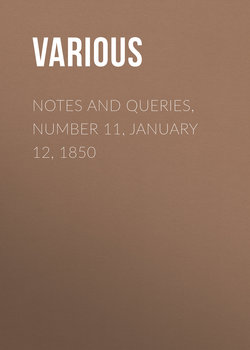Читать книгу Notes and Queries, Number 11, January 12, 1850 - Various - Страница 6
BILLINGSGATE
ОглавлениеI think your correspondent in No. 6. p. 93., starts on wrong premises; he seems to take for granted that such a structure as Belin's Gate really existed. Now the story entirely rests on the assertion of Geoffrey of Monmouth. What amount of credit may be placed on that veracious and most unromantic historian, your correspondent doubtless knows better than myself. Geoffrey says, in the 10th chap. of the 3rd book, that Belin, among other great works, made a wonderful gate on the bank of the Thames, and built over it a large tower, and under it a wharf for ships; and when he died his body was burned, and his ashes put into a golden urn on the top of the tower. Stow seems to doubt it. In Strype's edition, 1720, he says, concerning this gate, "Leaving out the fable thereof faming it to be builded by King Belin, a Briton, long before the incarnation of Christ." Burton, writing 1722, mentions the legend, but adds, "But whether of that antiquity is doubted." and John Brydall, in 1676, mentions it only as a wharf or quay for ships. Now, as Geoffrey of Monmouth's Chronicle is generally allowed by critics to be but a mass of romance and monkish legends, built on a slight foundation of truth, we may suppose this account to partake of the general character of the rest of the work. That some circumstance gave rise to the name is not doubted. "Haply," says Stow, "some person of that name lived near." I look on the name as only a corruption or romantic alteration of the word Baal or Bel; and, as we have every reason to suppose he was worshipped by part of the aborigines of this country, I deem it not improbable that on or near this spot might once have existed a temple for his worship, which afterwards gave a name to the place. It is true Baal generally had his temples placed on the summit of lofty mountains or other eminences. But supposing a number of his votaries to have settled near London, and on the banks of the Thames, nothing would be more likely than, to obviate the natural lowness of the ground, they would raise a tower for the better celebration of the ceremonies attendant on his worship. This might have been the foundation upon which Geoffrey built his story. However, I only suggest this. The real origin of the name I am afraid is too far sunk in oblivion to hold out any hopes of its being rescued at the present day.
VOX.
If "WILLIAM WILLIAMS" will examine the map of London in 1543, lately engraved from a drawing in the Bodleian Library, he will perceive the "Water Gate,", about which he inquires, defended on the west side by a lofty hexagonal machicolated tower.
C.S.
